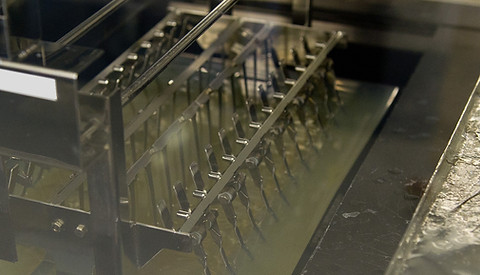

Corrosion:
DIN EN ISO 8044 defines the concept of corrosion. There are over 30 types of corrosion. The best known is the oxidation of iron to rust. Here, the iron reacts with the oxygen present in the environment which leads to changes in the appearance of the surface and a deterioration of the material properties.
The economic damage caused by corrosion must not be ignored. It is estimated to be 3-5% of the GDP of a country annually. The damage to a company’s image as a result of corroded products has not been included in this equation. It is therefore all the more important to optimally protect corrosion-sensitive products against corrosion.
Several options of corrosion protection, largely based on the particular requirements, exist to avoid costly corrosion damage. Especially during transport or when in storage, metallic products are exposed to extreme corrosive loads. To counteract these corrosive loads, a temporary corrosion protection is essential.
Temporary Corrosion Protection:
Temporary corrosion protection is understood to be a time-limited corrosion protection which, after having been applied, can be removed without leaving any residue. In contrast to a temporary protection, metallic products can also be permanently protected against corrosion by electroplating, painting or by means of a solid polymer coating. In regard to all these corrosion protection techniques it must be ensured that no direct contact between water and metallic surfaces remains, since water plays a central role in the corrosion process. Salts, environmental pollutants and other corrosive substances accelerate this process.
There are three basic ways to build up a temporary corrosion protection: Preservation with VCI, a desiccant, or oil / Tectyl. All three methods of preservation are effective, but differ significantly in cost, environmental impact and handling effort.
Volatile Corrosion Inhibitor - VCI:
Active VCI agents form a full-surface, corrosion-protective layer on metallic surfaces within a packaging. Direct contact between the metal surface and surrounding moisture is thus prevented. After opening the packaging, the inhibitors volatilize and the previously formed protective film disappears again from the material surface without residue.


Oel / Tectyl Coating:
By spraying, brushing or dipping, the metal surface is wetted with oil or Tectyl. This oil or Tectyl film on the metal surface prevents direct contact between water and metal. This protects the metal from corrosion. For subsequent processing, the oil or Tectyl must again be removed from the surface in a laborious process.

Dessicant Preservation:
In dry preservation packaging a desiccant is used to reduce the humidity inside the packaging to the extent that corrosion can no longer take place. By taking into account a number of various factors, the quantity of desiccant required is calculated and it is placed inside the packaging. For this type of corrosion protection to function properly, it is necessary that the outer packaging is hermetically sealed.
